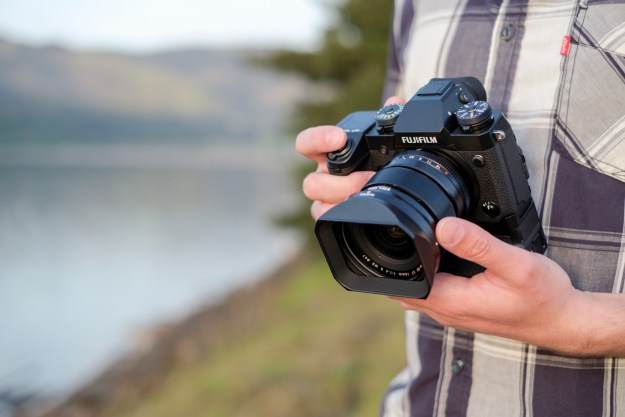
“The X-H1 offers a refined, polished shooting experience like only Fujifilm can.”
- Impressively well designed and built
- 5-axis in-body image stabilization
- Cinema 4K video at 200Mbps
- 3.69-million-dot electronic viewfinder
- Eterna film simulation
- Face detection AF can be unreliable
- Some audio bugs using external microphones
Fujifilm has made a name for itself by focusing on a specific corner of the photography market, making retro camera designs that rival Leica on looks, without the exorbitant price. It plays to its strengths, drawing inspiration from a long history of analog photography to provide modern photographers a hint of the pre-digital shooting experience. It’s a strategy that has worked well for the company that has “film” in its name, which is why the new X-H1 mirrorless camera is so surprising.
At its core, the Fujifilm X-H1 is simply a revamped X-T2 — which received a Digital Trends Editors’ Choice award in our review — and is built around the same 24-megapixel APS-C sensor and X-Processor Pro image processor, with many of the same performance specifications. The sensor now rests inside a 5-axis gimbal, however, bringing in-body image stabilization to a Fujifilm camera for the first time. This is a very welcome addition as the lack of stabilization has been one of our few lingering complaints about other Fujifilm cameras.
Additionally, the X-H1 receives an updated video mode with a higher bitrate codec, DCI 4K resolution (4,096 × 2,160), internal F-Log recording, and a new film simulation mode based on Fujifilm Eterna, a once popular, now discontinued motion picture film. There’s also a new touchscreen that enables a silent movie operation mode, in which users can change exposure settings without physically turning any dials.
A high-tech, powerful machine that addresses the needs of the modern hybrid photographer.
This all leads to a camera that is decidedly more modern and less retro. It’s a brave new direction for Fujifilm, which seems to be moving forward with reinvigorated confidence. The X-H1 isn’t just a camera for those who yearn for the analog experience of yesteryear; it’s a high-tech, powerful machine that addresses all of the needs of the modern hybrid photographer.
That’s all well and good, but the X-H1 is also arriving at a time when competition has never been fiercer. It may be a radical new move for Fujifilm, but in the context of the larger industry, we can’t help but feel like the $1,900 flagship is just playing catch-up.
Fujifilm’s best design yet
While much of the X-H1’s tech is tried and true, it is wrapped in a completely new camera body that is larger and more rugged than the X-T2. The grip is deeper, the weather seals are more robust, and the underlying magnesium skeleton is thicker and stronger than before. Even the lens mount has been rebuilt to better withstand shock and damage. It still takes design cues from its X-series cousins, but it is the most drastic new look for a Fujifilm since 2014’s X-T1 first introduced the DSLR-like design.

While some users will undoubtedly balk at the increased size and weight, we found the new design to be more comfortable than that of the X-T2. The grip is excellent, among the best of any mirrorless camera. The larger eyecup makes for clearer use of the electronic viewfinder — which has seen a resolution bump up to 3.69-million dots. The shutter button is placed farther forward in a more natural position atop the grip. It is also a “regular” button, with a wide, flat surface, compared to the smaller shutter button of the X-T2, which was modeled after classic mechanical film cameras and threaded for a cable release.
The front and rear command dials, used to dial in 1/3-stop exposure adjustments and control some other functions, have increased resistance and more obvious click points compared to the X-T2. This should help cut down on the number of accidental adjustments.
The dedicated ISO and shutter speed dials see their return, while the drive mode dial has a new CM position between CL and CH, for medium-speed continuous shooting. X-T2 users may lament the lack of an exposure compensation dial; its job has been relegated to a small — and somewhat difficult to reach — modifier key. However, its removal was to make way for a new top information display, which Fujifilm calls the “sub monitor.”
Some users will undoubtedly balk at the increased size and weight.
The sub monitor is a really nice touch and offers much more customization than the usual top LCD displays found on other cameras. Borrowed from the medium-format Fujifilm GFX, the electronic ink screen allows users to customize what and where information is displayed, with separate options for both still and video modes. It can also be set for either white text on a black background, or black text on a white background, and has a backlight for visibility in the dark. It is the most useful display of this type on any comparable mirrorless camera or DSLR.
Because of the redesigned body, there is also a new battery grip — the VPB-XH1 Vertical Power Booster Grip ($329, or kitted with the camera and two extra batteries for $2,199). We were able to test it for this review, and we really like it. It is built with the same attention to detail that Fujifilm applied to the rest of the camera.
The battery grip’s top surface is covered in a felted material, which we suppose is to avoid scratching the underside of the camera. Even the locking screw hasn’t been ignored; it has some resistance to it so that it rotates more smoothly, offering a reassuring tactile sensation. The grip fits very snuggly and the camera is specifically designed to allow areas of the grip to overlap it while all the edges still rest flush with the body. When attached, the grip truly feels like part of the camera rather than an add-on piece.
This obsession over triviality may not be necessary, but it makes for a very premium feel and is one of the reasons why Fujifilm has such a passionate user base.
In terms of practicality, the VPB-XH1 adds two additional batteries and improves ergonomics for both vertical shooting and horizontal shooting, at least for those of us with bigger hands. It adds duplicate front and rear command dials, AE-L and AF-On buttons, and an AF joystick. It also pushes continuous shooting speed up to 11 frames per second (fps) with the mechanical shutter, compared to 8 fps without the grip. In video mode, it extends the clip length limit from 15 to 30 minutes.
Particularly for video work, we highly recommend dropping the extra cash for the grip. The X-H1 gobbles up electrons a bit faster than the X-T2, with a CIPA-rated battery life of 310 shots compared to 340. In video mode, we drained two batteries in about 2.5 hours of use, with around 30 minutes of actual recording during that time.
We highly recommend dropping the extra cash for the grip. The X-H1 gobbles up electrons a bit faster than the X-T2, with a CIPA-rated battery life of 310 shots compared to 340. In video mode, we drained two batteries in about 2.5 hours
Fortunately, monitoring battery life is easy thanks to the sub monitor, which lets you keep tabs on all three batteries at a glance, even when the camera is turned off. Both in the monitor and in the physical battery tray, the batteries in the grip are labeled “L” and “R,” so there should be no confusion about which battery needs to be replaced. This may seem like another small thing, but details like this do a lot to improve the user experience.
Finally, there are some things the X-H1 hasn’t changed that we wish it had. The LCD, for example, has the same, limited amount of articulation as the X-T2, capable of tilting up and down or to the right — but not the left. That right-tilt is handy for portrait orientation shooting on a tripod, but a fully articulating screen would have been nicer.
The physical connections are also the same, using a standard USB 3.1 port, rather than the newer USB-C, and a Micro HDMI (Type D) port, the most annoying and noncommittal of all HDMI connectors. Swapping in a USB-C port would have provided room for a full-size HDMI port which, given the X-H1’s increased focus on video, would have been a good move in our opinion.
Sensor-shift stabilization and a (nearly) silent shutter
Fujifilm once said that in-body image stabilization was incompatible with its XF mount. The company also once admitted that the X-Pro2 couldn’t handle 4K video. Apparently, finding ways to do the impossible is Fujifilm’s modus operandi, as the X-Pro2 now shoots 4K and the X-H1 has introduced an honest-to-goodness, 5-axis sensor-shift stabilization system.
Sensor-based stabilization changes the game, letting you shoot with both the benefits of a fast aperture and stabilization.
The company claims it is good for up to 5.5 stops of shake reduction power, which certainly seemed believable in our testing. With a 60mm lens and a subject distance of about 5 feet, we were able to shoot handheld at a shutter speed as low as 1/4 second with acceptable sharpness (for non-moving subjects, anyway). This is beyond impressive for a camera system on which such technology was previously thought to be impossible.
While many manufacturers have already incorporated similar in-body stabilization systems, it is a particularly big deal for Fujifilm. The X-series prides itself on the number of high-quality, fast prime lenses it offers. Unlike zooms, prime lenses rarely incorporate optical stabilization.
In this review, we shot three lenses — the XF 16mm F1.4, XF 35mm F1.4, and XF 60mm F2.4 macro — none of which are stabilized. Sensor-based stabilization changes the game, letting you shoot with both the benefits of a fast aperture and stabilization. This becomes all the more important for video, and given the X-H1’s enhanced movie mode, in-body stabilization simply makes sense.

There is one oddity, however, in how the system engages. Most cameras activate stabilization on a half-press of the shutter button, but the X-H1 offers two choices: “continuous” or “shooting only.” In the former, stabilization is active all the time whenever the the camera is powered on. In the latter, stabilization only turns on when you take a picture — that is, it engages in the same instant as the shutter itself.
Both modes produce equivalent results, but it is only in continuous mode that you can preview the effect of stabilization before taking the shot, and this can really help with framing when using telephoto or macro lenses.
With a 60mm lens and about 5 feet away, we were able to shoot handheld at as low as 1/4 second with acceptable sharpness (for non-moving subjects, anyway). This is beyond impressive for a camera system on which such technology was previously thought to be impossible.
We’re unsure why there is not the option to activate stabilization on shutter button half-press, as this would presumably help conserve battery life while still letting you preview your shot with the assistance of stabilization.
Another thing missing is a multi-shot high-resolution mode. Found on cameras like the Panasonic G9 and Olympus OM-D E-M1 Mark II, such a mode can shift the sensor in between exposures by half a pixel’s width to capture additional detail. This is a great feature for landscape and still life photographers, and certainly would have helped give the X-H1 a decisive image quality edge. While we don’t know Fujifilm’s reasons for not including such a mode, we speculate it may have something to do with the X-Trans sensor, which uses a more complex pixel arrangement and thus might require more complicated sensor shifting and processing.
As for the shutter mechanism itself, it is all new — and much quieter than the X-T2’s. Of course, if you want truly silent operation, you can turn on the electronic shutter. This lets you shoot beyond the 1/8,000-second limit of the mechanical shutter, but does increase the chance of distortion from rolling shutter, which causes fast-moving objects to look slanted.

You also have the option of using just an electronic first curtain shutter, which starts the exposure electronically and closes the mechanical shutter to stop it. This offers the best of both worlds by reducing shock and noise while still preventing rolling shutter distortion.
There are several different options for customizing how the shutter works and which type of shutter activates when, but we stuck with electronic first curtain. In this mode, the shutter is so quiet that we first thought we had inadvertently turned on the full electronic shutter — we hadn’t. Even in high-speed continuous shooting, the shutter fires away like a chorus of whispers. It’s almost silly how quiet it is, but it’s also useful. From wildlife to weddings, this will be a welcome change for many photographers.
Cinema 4K and internal F-Log
The X-T2 stunned when it brought 4K video to a Fujifilm camera nearly two years ago. While not an uncommon mirrorless camera feature for the likes of Sony and Panasonic — both of which have long digital video pedigrees — video had always felt like an afterthought for Fujifilm. The X-T2’s video mode, however, was actually good, using oversampling for better sharpness and even offering the option to output 4:2:2 8-bit video into an external recorder over HDMI. When recording externally, users could also choose the F-Log profile, Fujifilm’s logarithmic gamma curve that preserved more dynamic range than a standard profile. All of these were features generally reserved for higher-end video cameras.
The Eterna film simulation has a beautifully soft look with low contrast and muted colors.
The X-H1 takes everything about the X-T2’s video mode and makes it better. It can now shoot both UHD 4K (3,840 x 2,160) and DCI 4K (4,096 x 2,160), and it does it at 200 Mb/s — twice the bitrate of the X-T2. F-Log returns, but is now also available when recording internally. For 24-fps shooting, 1/48-second and 1/96-second shutter speeds can be selected, mimicking the exposure times of 180 and 90-degree shutter angles, respectively — considered “true” cinema shutter speeds.
Perhaps our favorite part of the X-H1’s new video mode, however, is the Eterna film simulation. Patterned after Fujifilm’s motion picture film of the same name, Eterna has a beautifully soft look with low contrast and muted colors. Our sample movie in this review was shot entirely in the Eterna profile, with only very minor color adjustments made in post. For the most control, you’ll still want to stick to F-Log, but Eterna is a great option if you want a filmic look without having to spend time color grading. (Eterna also looks great for still images, and we used it in all of our sample photos in this review.)
For all of the good, however, the X-H1 doesn’t keep up with the likes of the Panasonic GH5/GH5S when it comes to video. Fujifilm’s 200Mbps, 8-bit codec can’t keep up with the 400Mbps, 10-bit one offered on the Panasonics. We also found continuous AF performance to lag behind the competition, particularly with regard to face detection, which often locked on to non-face patterns in the background rather than our subject’s face. It worked much more reliably with a single-color background, but the system seems to get confused easily.
Fujifilm is no stranger to rolling out AF improvements in firmware updates, so hopefully this will change down the road. (An update is scheduled for early May that offers general phase detection AF improvements, but does not mention specific enhancements to face detection.)
We should also note that simultaneous internal/external recording capabilities are limited. 4K can only be sent to one destination; you can choose whether that is the SD card or HDMI output, but the other one will be forced to Full HD.
There are also some curious audio issues. When using an external mic, we found that audio would occasionally cut out entirely while adjusting the levels in-camera. Restarting the camera fixed the issue, but didn’t prevent it from happening again. When monitoring with headphones (an option only available when using the battery grip), we also noticed a considerable amount of static, leading us to believe our audio was clipping even when it was not.
However, at the end of the day, we were quite pleased with the results — and this is what counts most. Despite the downsides, this is easily the best video mode to ever grace a Fujifilm camera, made even better by the inclusion of sensor-shift stabilization.
But it’s worth pointing out that the X-H1 is not the “video version” of the X-T2. Rather, it is a higher-end camera through-and-through, with improvements for both photo and video shooters. It won’t be the camera of choice for dedicated videographers, but it will allow still photographers — notably, those already entrenched in the Fujifilm X-series — to create higher quality motion content.
Still image quality
As the X-H1 uses the same sensor and processor combination of many previous Fujifilm cameras, we don’t have anything new to say here. But here is a brief recap: Image quality is very good throughout most of the ISO range, with excellent detail at base ISO. Noise is well-controlled through ISO 6,400, and in-camera noise reduction works well at these higher levels, but can be a bit heavy-handed.
As always, dynamic range diminishes as the ISO is turned up, and we definitely ran into problems when shooting live music in a bar with mixed lighting. In this situation, the stabilization didn’t help us as we had to shoot a fast shutter speed in order to prevent motion blur. When slower speeds are acceptable, the X-H1 will have an edge in low-light shooting as the stabilization will let you shoot at a lower ISO.
The only really new thing about the X-H1’s image quality is the Eterna film simulation. We instantly fell for its muted tones and film-like aesthetic. However, we’re a bit miffed by the fact that Fujifilm has not stated any plans to bring this profile to its other cameras. Other features introduced with the X-H1 — like internal F-Log recording — are coming to the X-T2, but not Eterna.
We hope this changes, because Fujifilm’s film simulations have always been one of its key differentiators, and Eterna is probably our favorite yet. (And yes, we understand if you shoot in RAW, you could technically develop your own profile that mimics the Eterna look, but we prefer to have it built-in.)
Warranty
Fujifilm offers a one-year warranty on all new cameras.
Our Take
The X-H1 is Fujifilm’s most powerful and most refined camera yet. It is clearly the result of thoughtful work, a result of taking the time to get things right — at least, most things. But the X-H1 is hitting the market at the same time as many other impressive cameras. It’s as if you put extra time into getting ready for a party, only to show up five minutes late to find someone else wearing your same outfit.
At $1,900 ($2,200 as tested with the VPB-XH1 grip), the X-H1 is also Fujifilm’s most expensive X-series camera to date. While that appears reasonable when you account for all that it offers over the X-T2, it also pushes it dangerously close to full-frame territory. The new Sony A7 III, for example, is just $100 more.
The X-H1, then, appeals most strongly to photographers already cemented in the Fujifilm camp, but it may not offer enough to lure X-T2 or X-Pro2 users into an upgrade. For some people — video shooters, in particular — the stabilization, higher-res viewfinder, and improved ergonomics will make the X-H1 a must-buy. But many others will likely be content to stick with their current gear.
However, as we’ve experienced with other X-series models, the X-H1 has a certain mysterious power to it. With it sitting on the desk next to you, you will feel compelled to stop what you’re doing, pick it up, and go shoot. It is perfectly weighted, substantial yet nimble, and it simply feels good to hold in your hands. Its quirks and imperfections become part of the creative process, and the beautiful results — both in still and video modes — speak for themselves.
There may be many equally capable cameras out there, some for even less money, but no one else — save Leica — has figured out how to imbue a machine with so much character the way Fujifilm has. You won’t shoot the X-H1 because you have to; you’ll shoot it because you want to.
Is there a better alternative?
With each new generation of camera, this question becomes harder to answer succinctly. The answer is almost always, “It depends.” Looked at as a whole, the X-H1 is absolutely unique, bringing together retro styling, a refined sense of elegance, and high-tech features like no other camera does. But it also fails to definitively outperform other cameras in its class in any one specific metric.
The Sony A6500 is less expensive, offers a very similar sensor with stabilization, and has roughly equal video features. The Panasonic G9 is also cheaper, and while its smaller Four Thirds sensor can’t match the X-H1 for still photo quality, it offers an impressive 80-megapixel multi-shot mode and a wealth of peerless features like 4K and 6K photo. Then, of course, there’s the aforementioned Sony A7 III, which will put you into the coveted full-frame club.
How long will it last?
Typically, Fujifilm’s flagship cameras have a shelf life of about 2.5 years, before a new model is introduced. The X-H1 does not replace any other camera, so we’re seeing the birth of a new line here. That said, we fully expect that other model lines will leapfrog the X-H1 as they are updated. The as yet unannounced X-Pro3 and X-T3 — presuming Fujifilm sticks to its naming conventions — may include updated tech not found in the X-H1, and those cameras are likely to appear well before 2.5 years from now.
As far as build quality is concerned, the X-H1 is the best Fujifilm camera ever made, and, quite frankly, one of the best from any manufacturer. It should last for many years to come in that regard.
Should you buy it?
Even among such stiff competition, the right user will be very happy with the X-H1 and we have no problem recommending it — so yes. But figuring out if this is the right camera for you may take some effort. Despite all of the modernization and speed improvements, the X-series remains a system designed for photographers who prefer a more methodical approach, who like working with prime lenses, and who appreciate taking the time to set up the perfect shot. The X-H1 will be a joy to use for such people, while its beefed up video functions will be enough to prevent photographers being increasingly asked to produce motion content from jumping ship and looking for another brand.
Editors' Recommendations
- Fujifilm’s most-hyped camera has just started shipping
- Fujifilm’s GFX 50S II is the cheapest medium-format camera ever
- Fujfilm X-T200 vs. Fujifilm X-T30: A close call
- Sony A6100 vs. Fujfilm X-T200: Best beginner mirrorless cameras compared
- See how Fujifilm’s popular X100 camera has changed over the years




















